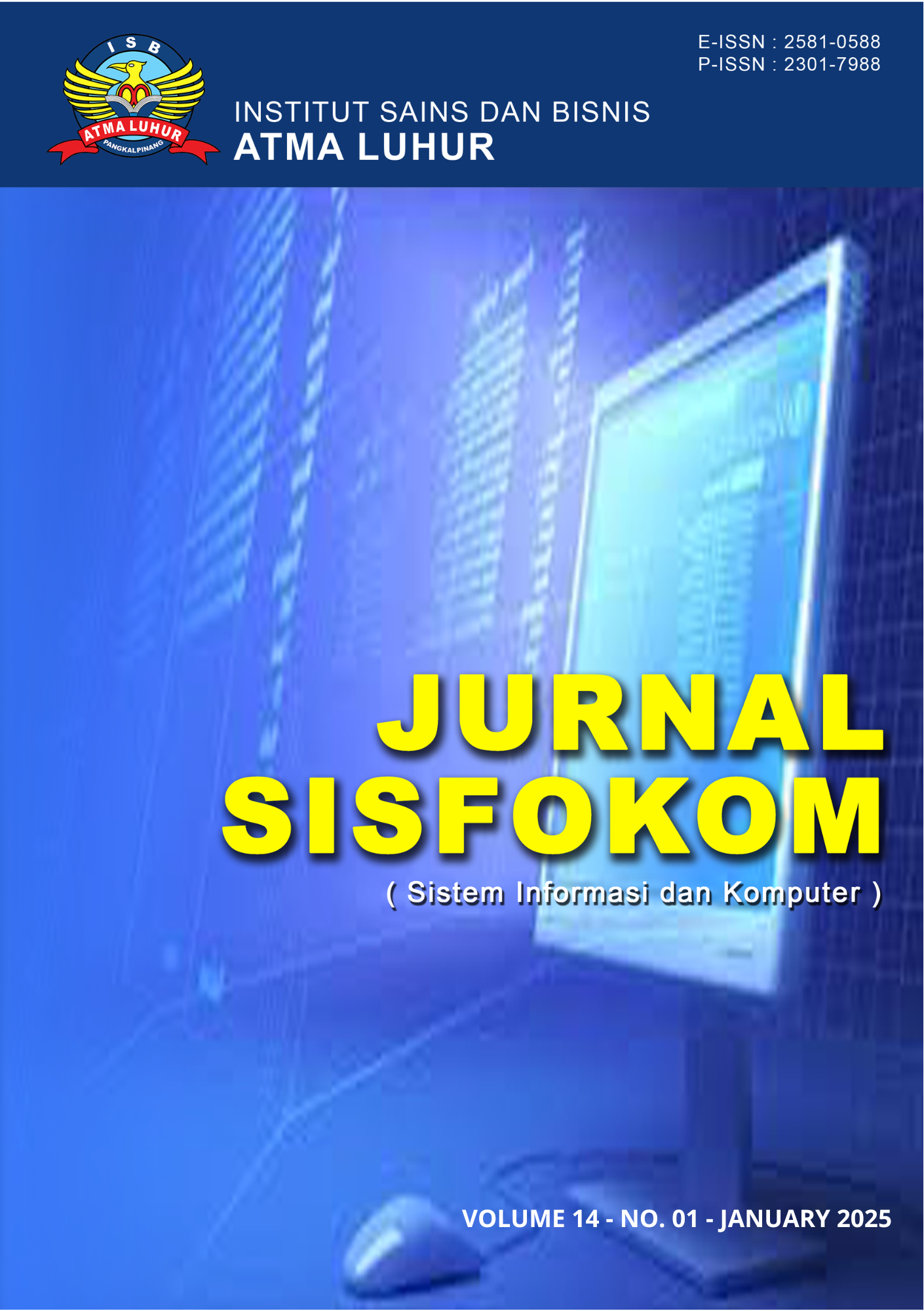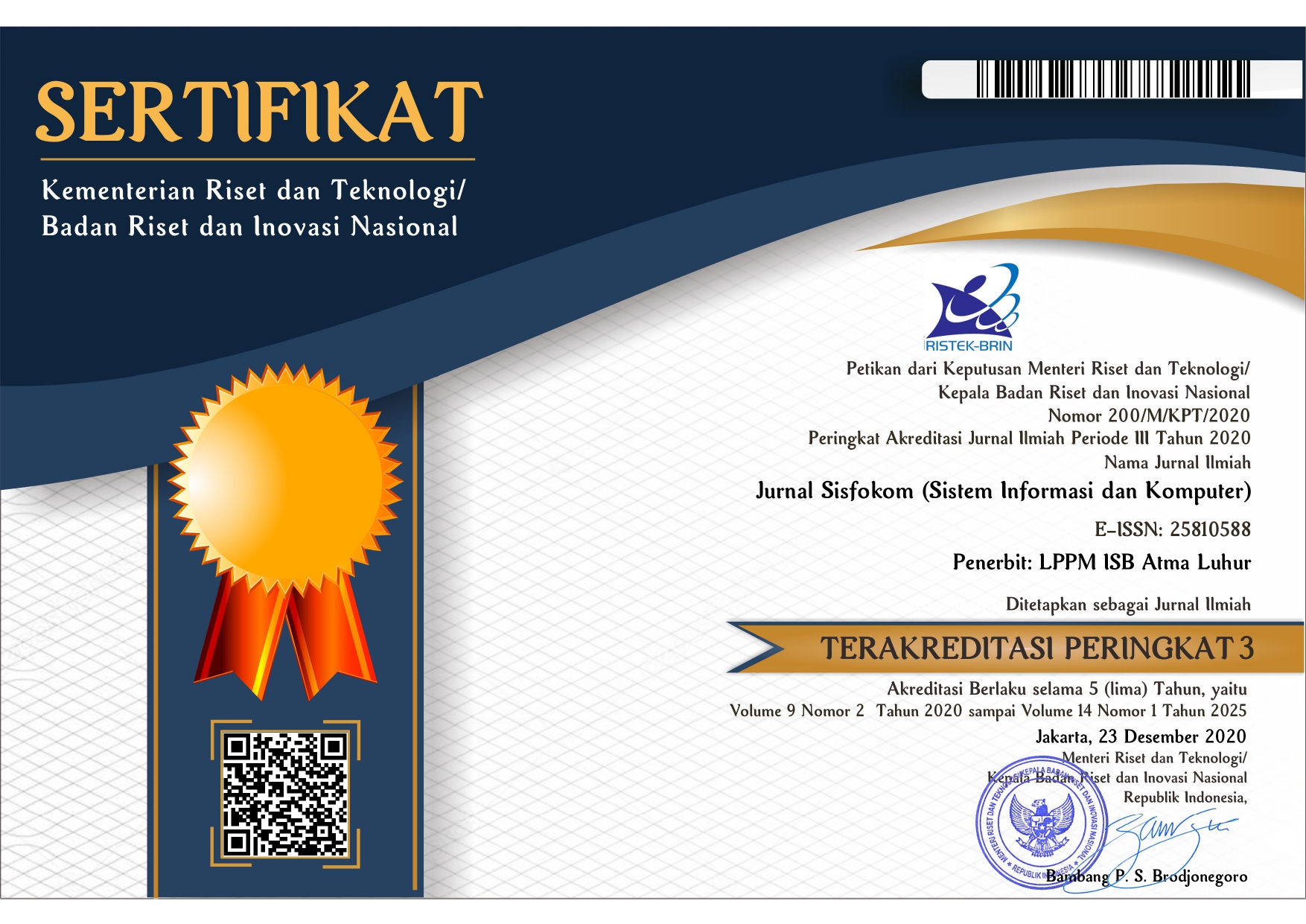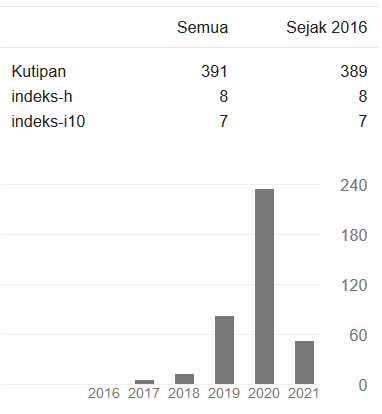VGG-16 Accuracy Optimization for Fingerprint Pattern Imager Classification
DOI:
https://doi.org/10.32736/sisfokom.v14i1.2317Keywords:
Fingerprint, Optimization, Classification, VGG-16. CNNAbstract
A fingerprint is a unique biometric identity commonly used as evidence in court. However, the quality of fingerprints can deteriorate due to external factors such as uneven surfaces, weather conditions, or distortion. This study uses the FVC2000 dataset and applies Convolutional Neural Networks (CNNs) to enhance and classify fingerprint images, focusing on patterns such as arches, loops, radial loops, ulnar loops, and twin loops. A novel aspect of this research is the optimization of the VGG-16 model by making specific adjustments to the hyperparameters, including setting the learning rate to 0.0001, using 50 epochs, and selecting a training-to- validation data split of 80%:10%. These adjustments were made to enhance the model’s ability to classify complex and varied fingerprint patterns, which typically present challenges to standard CNN models. The results of the study show the highest accuracy of 100% on the test data with the optimized parameters.These findings demonstrate that the optimized VGG-16 model successfully classifies fingerprint images with optimal performance. The real-world implications of achieving 100% accuracy include an increase in the reliability of biometric identification systems, especially for forensic and security applications that require high accuracy to ensure accurate decisions. This study makes a significant contribution to the development of CNN-based fingerprint classification systems, offering a new approach that supports more reliable and precise biometric applications.References
Albahli, Saleh, 2020, Detection of Coronavirus Disease From X-Ray Images Using Deep Learning and Transfer Learning Algorithms, Journal of X-Ray Science and Technology, Saudi arabia.
Andreansyah, Agus, Rika F, M. Jumnahdi., 2019, Pengenalan Pola Sidik Jari Menggunakan Multi-Class Support Vector Machine, Jurnal Elkha, pp. 79-84.
Andreea Monica Dinca, Lazarescu. dkk., 2022, A Fingerprint Matching Algorithm Using the Combination of Edge Features and Convolution Neural Network, MDPI Inventions, Romania, Pp. 39.
Arnita, Faridawaty, dkk, 2022, Computer Vision dan Pengolahan Citra Digital, ISBN 978-623-8230-27-3, Pustaka Aksara.
B. Bakhshi dan H, Veisi, 2017, End to End Fingerprint Verification Based on Convolutional Neural Network, in 27th Iranian Conference on Electrical Engineering (ICEE2019), Tehran, pp. 1994 -1998.
Cholussodin, Imam et al, 2020, Buku Ajar AI, Machine Learning & Deep Learning, Filkom, Universitas Brawijaya.
Cimtay, Yucel et al, 2021, Fingerprint Pattern Classification by Using Various Pre-Trained Deep Learning Networks, European Journal of Science and Technology (EJOSAT), Special Issue 24, pp. 258-261.
Emil Naf’an, et al, 2022, Dasar-dasar Deep Learning dan Contoh Aplikasinya, Penerbit: CV. Mitra Cendekia Media, Sumatra Barat.
Garg, Reena et al, 2024, Fingerprint Recognition Using Convolution Neural Network with intevesion and augmented techniques, Journal Elsevier, India.
Hadaris, Arisy Nabawi, 2020, Modul Daktiloskopi antara Tantangan, Peluang dan Harapan, Badan Pengembangan Sumber Daya Manusia Hukum dan Hak Asasi Mnausia Kementerian Hukum dan Hak Asasi Manusia Republik Indonesia, ISBN 978-623-6869-37-6, Percetakan Pohon Cahaya.
Hidayatullah, priyanto., 2023, Buku Sakti Deep Learning, Penerbit Stunning Vision AI Academy.
Hirsi Mohamed, 2021, Fingerprint Classification Using Deep Convolutional Neural Network, ISSN: 2329-1613, Journal of Electrical and Electronic Engineering, Turkey.
Indonesia, Undang-Undang tentang Kitab Undang-Undang Hukum Acara Pidana, UU No. 8 Tahun 1981, LN No. 76 Tahun 1981, Psl. 184.
Irsyad, Rahadian, 2018, Penggunaan Python Web Framework Flask untuk Pemula, Laboratorium Telematika, Institut Teknologi Bandung,
Liyananta, Mohammad et al, 2024, Klasifikasi Tumor Otak Menggunakan CNN dengan Arsitektur Resnet 50, Prosiding Seminar Nasional Teknologi dan Sains, Universitas Nusantara PGRI Kediri.
M. Galar et al, 2015, A Survey of Fingerprint Classification Part II: Experimental Analysis and ensemble proposal, Knowledge Based Systems, Vol. 81, pp. 98-116.
Purba, Nelvitia., Amran Basri, dkk., 2017, Kejahatan dan Penjahat dari Aspek Kriminologi, Mahara Publishing, ISBN 978-602-6914-78-1, Tanggerang, Banten.
Putra, Jan Wira Gotama, 2020, Pengenalan Konsep Pembelajaran Mesindan Deep Learning, wiragotama.github, Tokyo, Jepang.
Raharjo, Budi, 2022, Deep Learning dengan python, Penerbit: Yayasan Prima, ISBN: 978-623-5734-33-0, Semarang.
Ramesh Chandra Sahoo, dkk. 2019. Application of Deptwise Separable Convolutional Neural Network for Distorted Fingerprint Images, International Journal of control and automation. Vol. 12, No.6, pp. 448-455.
Sidik, Farih Maulana, 2024, 8 Kasus Pembunuhan Bikin Geger dalam Dua Pekan Terakhir, detiknews, diakses pada tanggan 8 Juni 2024 pada laman https://news.detik.com/berita/d-7334539/8-kasus-pembunuhan-bikin-geger-dalam-2-pekan-terakhir/1
Santoso, Joseph Teguh, 2022, Proyek Coding dengan Python, Penerbit: Yayasan Prima, ISBN: 978-623-5734-31-6, Semarang.
Satriawan, Akbar Muhammad dan Wijang, 2023, Klasifikasi Pengenalan Wajah untuk Mengetahui Jenis Kelamin Menggunakan Metode Convolutional Neural Network, Jurnal Algoritma, Vol. 4, No. 1, pp. 43-52.
Shrestha and B.K Malla, 2019, Study of Fingerprint Pattern in Population of a Community, J Nepal Med Assoc, Vol. 57 No. 219.
Supardi, Julian and Shi-Jinn Horng, 2019, Very Small Image Face Recognition Using Deep Convolutional Neural Network, Journal of Physisc: Conference Series 1196 (ICONISCSE).
Syarif Hartawan, Muhammad., Suhardjono, dkk., 2022, Digital Forensik, ARS Trainning,
Triwani, Pemeriksaan Dermatoglifi sebagai Alat Identifikasi dan Diagnostik, Fakultas Kedokteran, Universitas Sriwijaya, Palembang.
Downloads
Published
Issue
Section
License
Copyright (c) 2025 Jurnal Sisfokom (Sistem Informasi dan Komputer)

This work is licensed under a Creative Commons Attribution 4.0 International License.
The copyright of the article that accepted for publication shall be assigned to Jurnal Sisfokom (Sistem Informasi dan Komputer) and LPPM ISB Atma Luhur as the publisher of the journal. Copyright includes the right to reproduce and deliver the article in all form and media, including reprints, photographs, microfilms, and any other similar reproductions, as well as translations.
Jurnal Sisfokom (Sistem Informasi dan Komputer), LPPM ISB Atma Luhur, and the Editors make every effort to ensure that no wrong or misleading data, opinions or statements be published in the journal. In any way, the contents of the articles and advertisements published in Jurnal Sisfokom (Sistem Informasi dan Komputer) are the sole and exclusive responsibility of their respective authors.
Jurnal Sisfokom (Sistem Informasi dan Komputer) has full publishing rights to the published articles. Authors are allowed to distribute articles that have been published by sharing the link or DOI of the article. Authors are allowed to use their articles for legal purposes deemed necessary without the written permission of the journal with the initial publication notification from the Jurnal Sisfokom (Sistem Informasi dan Komputer).
The Copyright Transfer Form can be downloaded [Copyright Transfer Form Jurnal Sisfokom (Sistem Informasi dan Komputer).
This agreement is to be signed by at least one of the authors who have obtained the assent of the co-author(s). After submission of this agreement signed by the corresponding author, changes of authorship or in the order of the authors listed will not be accepted. The copyright form should be signed originally, and send it to the Editorial in the form of scanned document to sisfokom@atmaluhur.ac.id.









